64-850-P1 Masterproject Intelligent Robotics (Part 1)
| Room: | F-326 |
| Date: | Thursday, 12:15 - 15:45 |
| Organizer: | Michael Görner, Norman Hendrich |
Videos
Old Demo Video (17 MB mp4).
Marimbabot Scenario
The project focuses on the development of a robotic system capable of playing musical notes and chords on a marimba. The system integrates various technologies, including optical music recognition, audio command processing, and precise motion control. It employs a custom vision model to read musical notes from a whiteboard and utilizes voice recognition to interpret human commands, and finally evaluates the robot’s performance with audio feedback. The project encompasses hardware components, including 3D-printed com- pliant mechanisms and servomotors, to mimic human-like mallet strikes. This multifaceted project demonstrates the fusion of robotics, music, computer vision, and audio processing, showcasing a robot capable of performing a complex musical instrument with precision. The entire project, including code and documentation, can be found on GitHub.
"Marimbabot" Master Project Report
Final project report (3.3 MB pdf).
Final project demo slides (3 MB pdf).
https://github.com/UHHRobotics22-23/MarimbaBot Github repository.
Integrated Seminar
The integrated seminar 64-850-S: Integrated Seminar Intelligent Robotics complements the project.Appointments
The following schedule is tentative and will be updated according to the participants' previous knowledge and interests.- 20.10.2022:
- 27.10.2022:
- Assignment #2 (Turtlebot) [PDF] / turtlebot.rosinstall
- 03.11.2022:
- Assignment #3 (Robot Arm + Moveit) [PDF]
- Project Brainstorming
- 10.11.2022:
- Assignment #4 (ROS Services + Collaboration) [PDF]
- Project Brainstorming
- 17.11.2022:
- Project Brainstorming
- Literature research
- 24.11.2022:
- Seminar Presentation Berk Güngör - TossingBot [PDF]
- Seminar Presentation Yunlong Wang - Making Sense of Vision and Touch
- Project Brainstorming
- Literature research
- 01.12.2022:
- 08.12.2022:
- 15.12.2022:
- 22.12.2022:
- Project
- 29.12.2022: X-mas holidays
- 05.01.2023: X-mas holidays
- 12.01.2023:
- 19.01.2023:
- Seminar?
- Project
- 26.01.2023:
- Seminar?
- Project
- 02.02.2023:
- Project
- Milestone First Year
Tasks to be worked on in the project involve:
- Practical software development (cmake, catkin, Python and C++)
- Hands-on knowledge of robotics (e.g. UR5, PR2)
- ROS basics (incl. simulation, TurtleBot, navigation)
- Data visualization (RViz, Markers, plotjuggler, etc.)
- Image / Depth image processing (e.g. OpenCV, PCL)
- Robot Control (e.g. ros_control, MoveIt)
- Control Architectures (e.g. SMACH, BehaviorTrees)
- Debugging and testing (incl. rosbag)
Content
Within this project you shall learn how to basically program a robot to do tasks like navigating, manipulating, interfacing with humans. Therefore ROS (robot operating system) as the standard open-source middle-ware will be used to program the robot.
Prerequisites:
Experiences in programming C/C++ and/or PythonLanguage:
English and GermanStart:
Yearly starting in winter term.Keywords:
Computergrafik, 3D, Robotik. Mensch-Maschine-Interaktion, Bildverarbeitung, Locomotion, Sensortechnik, Manipulation, Grasping, computer graphics, robotics, human-machine interface, image processing, sensor fusion, localization, navigation, gesture recognitionLearning goal
The goal of the Master project is basically two-fold. First, you get hands-on knowledge about various methods and approaches from different aspects of state-of-the-art robotics. Second, you learn about how to organize work and how to collaborate in a group towards your self-defined project goal.Approach
You will be working as a group towards a specific robot application (demo) proposed and chosen by the students. The Master project runs over two semesters. In the winter semester (WS 2022), the project consists of two parts with individual STiNE numbers (64-580-P1 for the practical robot work and 64-580-S1 for the seminar part). The Master-project will be continued in the following summer term (4 SWS, no seminar part).
Successful participation includes literature review, self-acquiring of basic methods and concepts, development and tests of (robot) software, implementation of a prototype, presentation and documention of the results.
All reports including an oral presentation in the first semester will take place in the integrated seminar 64-850-S1.
Evaluation
To pass the course, students have to- successfully pass the seminar component (with graded presentations/seminar paper),
- contribute to the final robotic demonstration,
- take part in a final public project presentation, which includes the demonstration of the developed system,
- contribute sections to the final written submissions composed by the group at the end of the term (see next section).
Written Submissions
At the end of the project, the group has to document their efforts. This work is split in two parts.
First, all final source code and project structure that was developed during the project should be documented. The aim of this part is to enable a person with no affiliations to the project to run and develop on top of the final demonstration. Useful documentation includes a technical overview of each part (usually in the form of a README.md for each component) with sufficient instructions to start and develop the demonstration scenario. If there are known issues that can break demonstrations, these should be documented as well. Lastly, the actual source code should be sufficiently structured and commented to be accessible later on.
Second, all other aspects of the project should be summarized by the whole group in a document in the style of an IEEE conference publication of 6-10 pages in total. It should comprise everything you would expect to see in a scientific publication while abstracting away implementation details (which are documented in the first part already). Relevant sections might include
- Overall scope and structure of the developed system
- Related work of the system and the individual components
- Methods and considered alternatives for implemented components
- Limitations of the chosen approaches
- If experiments were performed, a conclusive evaluation of the observed effects.

